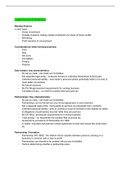Summary
Summary GDL Company Law Revision Notes (Distinction) BPP
- Module
- Company Law
Future Magic Circle Trainee. Total BPP Adapt Company Law notes. Includes all adapt materials, relevant cases (with summaries), legislation and precedents. All preparation that is needed for both workshop preparation and exams for Company Law.
[Show more]



